
Huntington is a city in Cabell and Wayne counties in the U.S. state of West Virginia. The county seat of Cabell County, the city is located at the confluence of the Ohio and Guyandotte rivers. Huntington is the second-largest city in West Virginia, with a population of 46,842 as of the 2020 census. Its metro area, the Huntington–Ashland metropolitan area, is the largest in West Virginia, spanning seven counties across three states and having a population of 376,155 at the 2020 census.

The Hinton Historic District is a national historic district located at Hinton, Summers County, West Virginia. The original Hinton Historic District is bordered roughly by the Chesapeake and Ohio Railroad line, James Street, 5th Avenue, and Roundhouse. The boundary increase extended the district to include Mill Street. It was listed on the National Register of Historic Places in 1984 and revised in 2005.
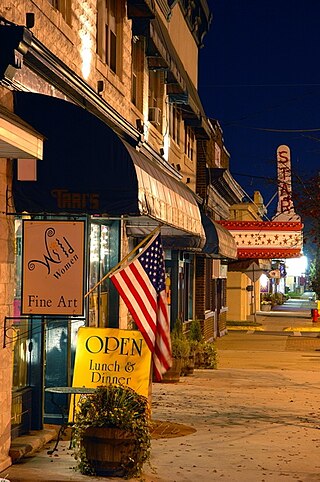
Town of Bath Historic District is a national historic district located at Berkeley Springs, Morgan County, West Virginia. The district encompasses 218 contributing buildings, 3 contributing sites, 6 contributing structures, and 1 contributing object. It consists of the community's central business district, along with the previously listed Berkeley Springs State Park, a small industrial area east of the downtown, and residential areas surrounding the downtown which also contain several churches and two cemeteries. The buildings are generally two stories in height and are primarily built of brick, wood, and concrete block, and set on foundations of native limestone and brick. Located within the district boundaries are the previously listed Berkeley Springs Train Depot, T. H. B. Dawson House, the Clarence Hovermale House also known as the Mendenhall 1884 Inn, the Sloat-Horn-Rossell House, and the Judge John W. Wright Cottage.

Sutton Downtown Historic District is a national historic district located at Sutton, Braxton County, West Virginia. It encompasses 85 contributing buildings and two contributing structures covering eleven square blocks. The district includes the commercial, ecclesiastical, and civic core of the town and surrounding residential area. The district includes a number of buildings representative of popular architectural styles from the late-19th century and early-20th century including Romanesque Revival, Colonial Revival, Gothic Revival, and Greek Revival. Notable buildings include the Braxton County Courthouse (1881-1882) and Jail (1905), Sutton Bank Building (1891), Farmers Bank and Trust (1909), Bank of Sutton, Methodist Episcopal Church, South (1896), Kelly / Fisher House. Elk / Midway Hotel (1894), and Katie B. Frame Residence. The two structures are the Bridge over Old Woman Run (1892) and Bridge over Elk (1930).

The Thomas Carroll House, also known as the Madie Carroll House, is an historic home located in the Guyandotte neighborhood in the city of Huntington, Cabell County, West Virginia. It is also known as one of the oldest structures in Cabell County. The original section of the house was built prior to 1810, and is believed to have arrived in Guyandotte by flatboat from Gallipolis, Ohio. The property was purchased by Thomas Carroll in March 1855 and remained under the ownership of his descendants until it was deeded to the Greater Huntington Parks and Recreation District on October 10, 1984, after the last tenant, Miss Madie Carroll's demise. It is one of the few houses in Guyandotte to survive the Civil War and even once was a church, an inn, and a home to many. During the Civil War the house was a safe haven for Union soldiers which is a rich history that the Madie Carroll House Preservation Society has spent the last few decades protecting and educating many on. As of today the house is owned and operated by the Madie Carroll House Preservation Society where they hold several events such as their annual Guyandotte Civil War Days. It is open to the public as a museum. It was listed on the National Register of Historic Places in 1973.
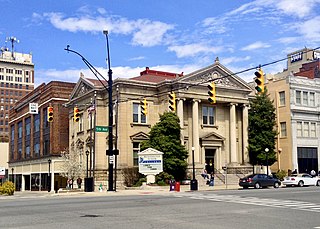
Carnegie Public Library, also known as Cabell County Public Library, is a historic library building located at Huntington, Cabell County, West Virginia. It was built in 1902–1903, in the Beaux-Arts style. It is two stories with a raised basement and has smooth gray ashlar walls. It features a pedimented, central front pavilion with paired Ionic order columns on its portico. The interior was renovated in the 1930s. It is one of 3,000 such libraries constructed between 1885 and 1919. Andrew Carnegie provided $35,000 toward the construction of the Huntington library. It served the community as a library until 1980, when a new library opened across the street. The building houses Huntington Junior College.
Hawthorne Historic District is a national historic district located at Huntington, Cabell County, West Virginia. The district encompasses 24 contributing buildings and 1 contributing structure in the Park Hills Subdivision No. 1. The district is composed entirely of early 20th century residences, the majority of which are Colonial Revival style.
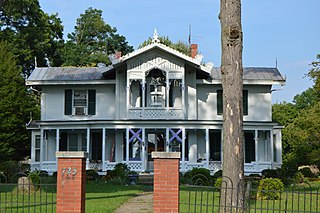
Ninth Street West Historic District is a national historic district located at Huntington, Cabell County, West Virginia. The district encompasses 12 contributing buildings in the St. Cloud neighborhood in the western section of Huntington. It is a significant enclave of late 19th and early 20th century residences in the Late Victorian style, most notably Queen Anne. The period of development is from 1870 to 1933.
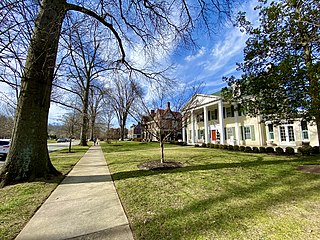
Ritter Park Historic District is a national historic district located at Huntington, Cabell County, West Virginia. The district encompasses 68 contributing buildings and 5 contributing structures, including the Ritter Park municipal park. The city purchased the park property in 1908. Dwellings in the district represent the finest styles in popular architecture from the years 1913 to 1940, including Colonial Revival, Bungalow/craftsman, and Tudor Revival. Notable buildings include the Ritter Park Apartments (1932), Weingartner House, Cammack House (1923), Marshall University President's House (1923), and Park Terrace Apartments.

Barboursville Historic District is a national historic district located at Barboursville, Cabell County, West Virginia. The district encompasses 20 contributing buildings in the central business district of Barboursville and mostly contains several good examples of late 19th and early 20th century commercial architecture. Notable buildings include the First United Methodist Church Parsonage, Brady Hardware Building (1906), First National Bank (1870), Ossie Mills General Store, Barber Shop, Adams Building (1950), and Miller/Thornburg Store (1854).
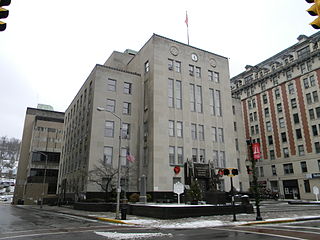
Clarksburg Downtown Historic District is a national historic district located at Clarksburg, Harrison County, West Virginia. The district encompasses 119 contributing buildings in 16 blocks of the central business district of Clarksburg. It includes an extraordinary variety of architectural types and styles including Renaissance Revival and Italianate. Notable buildings include the Goff Building (1911), Municipal Building (1888) [demolished], the Waldo Hotel (1901–1904), Robinson Grand, Harrison County Courthouse (1931-1932), U.S. Post Office (1932), Masonic Temple (1911–1914), Merchant's National Bank (1894), First United Presbyterian Church (1894), and First Methodist Church. Located in the district and separately listed are Waldomore and the Stealey-Goff-Vance House. The Nathan Goff, Jr. House was delisted in 1994.
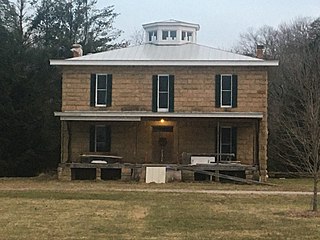
Gen. John McCausland House, also known as "Grape Hill," is a historic home located near Pliny, Mason County, West Virginia. The main house was built in 1885, and is a two-story sandstone residence. It features a full-length, one story, five bay porch with fluted Doric order columns and metal covered hip roof. The house was built by Confederate General John McCausland (1836–1927). The boundary increase expanded the listing to include 23 additional contributing buildings and 4 contributing structures and designated it a national historic district. They include a variety of farm-related outbuildings and a log house.
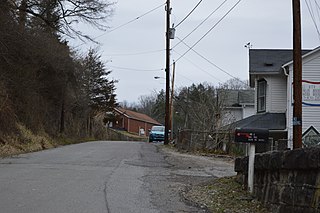
Bramwell Additions Historic District is a national historic district located at Bramwell, Mercer County, West Virginia. The district originally included 151 contributing buildings, 8 contributing sites, 5 contributing structures, and 2 contributing objects. The boundary increase added 27 contributing buildings and 1 contributing structure. The non-contiguous district encompasses formerly independent coal mining oriented communities now incorporated into Bramwell. These communities include Freeman, Ramey Addition, Simmons, and Cooper. The district is characterized by company houses built as residences for miners.

Chancery Hill Historic District is a national historic district located at Morgantown, Monongalia County, West Virginia. The district originally included 109 contributing buildings and 1 contributing site, Oak Grove Cemetery. A boundary increase in 2001, added the already listed Alexander Wade House to the district. The district encompasses a residential area developed in the early-20th century on property that was once the farm of U.S. Senator Waitman T. Willey. It includes examples of popular architectural styles from that period including Queen Anne, American Foursquare, Colonial Revival, and Bungalow.
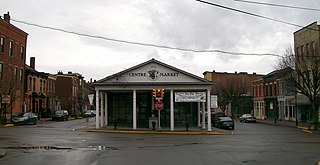
Centre Market Square Historic District is a historic district in Wheeling, West Virginia, listed on the National Register of Historic Places.

North Wheeling Historic District is a national historic district located at Wheeling, Ohio County, West Virginia. The district encompasses 134 contributing buildings and one contributing object in a 2 1/2-block section of northern Wheeling, known as "Old Town". Most of the district consists of mid- to late-19th-century residential buildings. A number of popular architectural styles are represented, including Greek Revival, Italianate, and Late Victorian. Notable buildings include the Vigilant Engine House, William Goering House (1885), Alfred Paull House (1880s), Williams Duplex Tenement (1880–1884), George W. Eckhart House (1891–1892), Christian Hess House (1876), Edward Hazlett House (1893), Henry K. List House (1858). The object is the Pollack Memorial Monument (1916).

Wheeling Warehouse Historic District is a national historic district located at Wheeling, Ohio County, West Virginia. The district includes 20 contributing buildings and 11 contributing structures. They are warehouses and commercial style buildings and structures between Main Street and the Ohio River. All of the buildings date to the late-19th and early-20th century. The warehouses are mostly two- and three-story masonry buildings. The two-story commercial buildings have storefronts on the first floor and residential units above. Notable buildings and structures include the Pump Store (1933), Wheeling Stamping Plant (1932), Allied Plate Glass, Warwick China, Boury Warehouse, Ott-Heiskell Company, Edward Wagner Wholesale Grocers building (1915), the Moderne style former Greyhound Bus Station, and Main Street Bridge (1891).

Kingwood Historic District is a national historic district located at Kingwood, Preston County, West Virginia. The district encompasses 103 contributing buildings in the central business district and surrounding residential areas of Kingwood. Most of the buildings are two story, frame and masonry buildings. Notable buildings include the Preston County Courthouse (1934), Kingwood National Bank Building (1908), C.M. Bishop House (1872), Preston Academy (1842), IOOF Lodge, Bank of Kingwood (1900), Bishop Block (1877), Presbyterian Church (1878), Methodist Church (1879), Wilson Building (1930), and Loar's Service Station (1927). Located in the district and listed separately is the James Clark McGrew House.

Downtown Rowlesburg Historic District is a national historic district located at Rowlesburg, Preston County, West Virginia. The district encompasses 51 contributing buildings and 1 contributing site in the central business district and surrounding residential areas of Rowlesburg. Most of the commercial buildings are two story, frame and masonry buildings, dating from about 1900 to 1950. Notable buildings include the St. Paul's Methodist Protestant Church (1923), St. Philomena's Roman Catholic Church, Trinity Methodist Episcopal Church (1915), Rowlesburg School, Waybright House, Weaver House, Nassif Home and Store building, Rowlesburg Area Historical Society/IOOF building (1875), and Adams and Moore Store building (1907).

Beverly Historic District is a national historic district located at Beverly, Randolph County, West Virginia. It encompasses 51 contributing buildings that reflect the history of Beverly from its founding to the end of the 19th century. Notable buildings include the Randolph County Courthouse, old Randolph County Jail (1813–1841), Randolph County Jail (1841), Beverly Public Square (1787), Beverly Cemetery (1768), Beverly Presbyterian Church (1869), Beverly United Methodist Church (1890), Home of "The Enterprise", and the Peter Buckey House and Hotel (1790–1865). Also located in the district is the separately listed Blackman-Bosworth Store.























